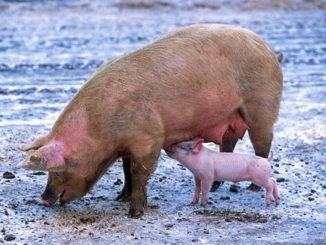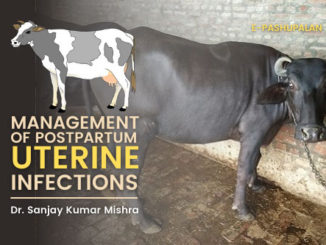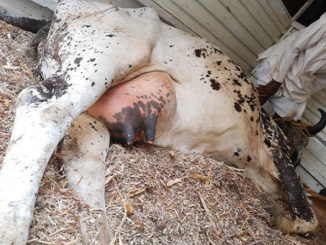Listeriosis caused by Listeria spp. is an important foodborne infectious disease of humans and animals, prevalent worldwide. Listeria spp. are ubiquitous bacteria widely distributed in the environment including water, soil, decaying vegetable matter, sewage, as well as a variety of food. Of the 17 recognized species of Listeria, two species viz., L. monocytogenes and L. ivanovii are considered pathogenic. L. monocytogenes is pathogenic for human and animals, while L. ivanovii is primarily pathogenic for animals and rarely causes disease in humans.
The disease is more prevalent in temperate countries as compared to tropical and subtropical countries. Listeria can infect a wide variety of animal species but it primarily causes a clinical disease of ruminants. Sheep and cattle are particularly susceptible and infection is rarely seen in goats, swine, horses, and poultry. The conditions that predispose the animal to the disease are reduced host animal’s resistance, poor nutrition, sudden changes in weather, stress due to late pregnancy, parturition or transport and long periods of silage feeding. The disease is also sometimes referred as silage sickness because of its association with ingestion of silage with pH > 5-5.5, poorly fermented silage or otherwise good silage in which aerobic deterioration has occurred. Highest incidence is seen in winter and early spring.
Listeriosis in animals is known as circling disease as “circling” is shown by the ruminants affected by encephalitis along with other neurological symptoms like ataxia, opisthotonus, in-coordination, head deviation, head tilting, and paralysis of cranial nerves, combined with hyperthermia, anorexia and depression. The most common clinical manifestation in ruminants is encephalitis, however third trimester abortions, stillbirth, retained placental membrane as well as atypical manifestations such as conjunctivitis have also been described. Septicemic listeriosis develops with or without meningitis, most commonly in neonatal ruminants and in adult sheep and goats.
The diagnosis of the disease can be made based on clinical signs. Isolation of organism can be done from placenta, fetus or uterine discharges after an abortion; in the blood of septicemic animals; and in postmortem tissue samples such as the liver, spleen, kidneys, and brain. However, specialized enrichment techniques are needed to recover organisms from contaminated samples such as faeces or food and from the brain, where they occur in low numbers. Molecular tools like PCR can also be employed. The disease needs to be differentially diagnosed with other neurological diseases like pregnancy toxaemia in sheep, nervous ketosis, rabies, polioencephalomalacia, and scrapie in cattle.
Penicillins are considered to be the drugs of choice for listeriosis, but other antibiotics including tetracyclines are also used. Chlortetracycline @ 10mg/kg BW/day for 5 days and injection penicillin @ 44000 IU/kg BW, I/M daily for 7 days or 10-14 days is recommended. Besides that, supportive therapy using parenteral fluids, neurotropic vitamins and minerals is also given. In order to prevent listeriosis in ruminants, feeding good quality silage is very important. The silage with Listeria growth can also appear normal therefore the superficial few inches that is exposed to air and any spoiled or moldy silage should not be fed to the animals. The leftover silage should be removed after feeding and silage handling tools cleaned to prevent cross-contamination.
In humans listeriosis is predominantly a food related illness since 99% of all human listeriosis cases result from consumption of food products contaminated with L. monocytogenes such as raw meat, fish, milk, milk–related products, raw vegetables, salads, unheated ready-to-eat meals etc and not directly from animals. However, unpasteurized milk and uncooked meat can act as a source of transmission, and zoonotic infections occasionally occur after direct contact with sources such as the placenta or fetus. Food with a long shelf-life under refrigeration, foods that are consumed without further treatment such as cooking, dairy products such as soft cheeses and ice cream are most often associated with listeriosis. The disease can also be transmitted from person to person or notably from pregnant women to unborn babies.
The organism has been attributed as an important food borne pathogen and can easily multiply under suitable environmental conditions leading to contamination at all steps of the food chain. The optimum growth temperature of L. monocytogenes lies in the range of 30 to 37°C but it has the ability to grow at temperatures less than 15°C and therefore it is considered a psychrotolerant organism. It can grow in a wide pH range from 4.5 to 9.0, in low water activity environments (aw 0.92) and at refrigeration temperatures (2-4℃), and tolerate NaCl concentrations as high as 12% which are generally lethal to other microorganisms. L. monocytogenes can multiply under both aerobic and anaerobic conditions, adapt to disinfectants and adhere to various surfaces. Because of its ability to form biofilm and persist for a long time under adverse conditions, it has been isolated from different processing environments which makes L. monocytogenes a significant threat to public health.
Among healthy people listeriosis occurs as a self-limited acute febrile gastroenteritis but is causes life-threatening invasive illness in people with weakened immune systems, older adults, newborns, pregnant women and their unborn babies characterized by septicaemia, abortion, still birth, perinatal infections, meningitis and meningoencephalitis. L. monocytogenes has been reported to cause highest hospitalization rate (90.5%) of all the foodborne pathogens (Centers for Disease Control and Prevention, 2000) and ranking second among the most frequent causes of death due to foodborne illnesses after salmonellosis. In order to prevent infection by L. monocytogenes, food should always be eaten after cooking and unpasteurized dairy products and raw meat should not be consumed.
|
The content of the articles are accurate and true to the best of the author’s knowledge. It is not meant to substitute for diagnosis, prognosis, treatment, prescription, or formal and individualized advice from a veterinary medical professional. Animals exhibiting signs and symptoms of distress should be seen by a veterinarian immediately. |







Great Article. Looking forward for more such informative articles.
Nice
Great job..!!
Nice
Great job!
Very informative mam
Good job👍🏻
Informative
Well constructed and very informative one.
Great information, keep it up
U doing a great job..👌👌
Superrb nd very informative and helpful article
Informative article
Quite informative, enlightening and helpful article !!
informative literature
Great work
Thanx for sharing this informative article. Your research on this topic will really be helpful, not only for humans but also for animals. Good job and keep it up.
Quite informative
Great article, very informative….knowledgable,instresting,helpful…must go through this article…keep it up…
Very insightful.
V. Nice and Informative..
Very informative article
Great work done.. Ma’am and sir👍👍
Really nice work, looking forward for more articles like this.💓
👍👍
Great article
Gud work, thanks for providing such important information. Looking forward for more work by uh…
Great work.. informative!
V.nice
Informative
There are two major methods of pasteurization available. One is LTLT (Low temperature, long time), other one is HTST (High-temperature, short time). Although several studies have shown that L. monocytogenes is inactivated by standard pasteurization practices, but under certain conditions the organsim has been found to survive the minimum high-temperature, short-time treatment. Therefore LTLT pasteurization is more effective in the elimination of the organism.
An important topic ,specially with respect to those engaged in animal husbandry ,presented in informative way.
concise n informative article.
Very good and informative article…
Is there any standard pasteurization process to remove the L. Monocytogenes.?
As I have read in an article that “L. Monocytogenes are relatively resistant to heat and have raised concerned about the pasteurization for the elimination of this organism from the milk.”
Good job.👍
Good article
Informative article
This is something really informative! We as a people need to be concerned about it! So good👏
Well done! keep going🤘
Informative article 👍
awesome research awesome article.
Good content and well written article.
These kind of articles are need of the hour.
Cool I appreciate who wrote this article
5🌟 Deserving Article…
Great work
Informative👌
Very Informative article.. Gud luck
Very informative articles. Gud luck
Very informative
Very NYC article
Nice informative
Shi kaha babuji agar mujhe angreji padni aati aur aise articles phle maine pade hote to aaj gada electronics nhi gada dairy Pvt Ltd hoti
very informative article
Very informative. Keep it up!
Informative article… Great work..
Great work done.
Aisa article phle pada hota to aaj tak humri bhasiya dhud ki ganga bha deti.
Very Informative .Good job
The dissertation is usefulness that I wouldn’t hesitate to say something about it.
Good job. Keep it up.
Very informative article..
Thank you for making me aware of such an important issue.
Great work!
Informative. Good job 👍👍
Great 👍
Consise and Useful 👍🏻
Great
Great work done.
Great job. Concise and informative article.
Nice information
Useful Information as include field level info.
Informatic article good doc 👍
Very informative
Very informative article
Good and informative👍
Great knowledge 👍🏻
Great article.. 👍
Informative article 👍
Informative article, grt work 👍
Great job..quite informative
Very good information
Good work.
Good one👍🏻
Informative!!
Informative!
Great article
Very insightful. Good job
Muchh inspiring …. great work done
Something really innovative ….much helpful article
Quite informative and instructive article.
Highly informative and good work.
Great research and helpful insights about an important foodborne infectious disease. Waiting for more such insightful articles.
Great article👍
Very good,interesting and informative article , great work 👍
Thx dr. For valuable information………
Great work
Thx for valuable information
Interesting article
Good information and we’ll prepared article..
Very informative and effective article….. Well done 👍
Quite informative doc 👍👍
Informative, thanks for sharing..👍👍
Concise and informative👍
Concise and comprehensive article..
Great article
Very informative
Valuable..very informative
Excellent article..!!
Got new information 👏👏
Keep posting article like this👍
Useful information
Nice work👏👏👏
Very informative… Great work.good luck.
Great article very informative 😲😊😊😊
Interesting & Help-full article 💯
Got to know something interesting. Thanks.
Quite insightful article. Great work